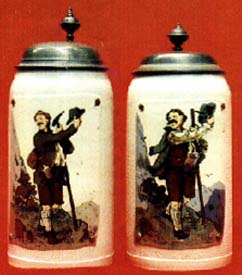
 |
What is a Tapestry Stein?
Giving a general definition that fits every tapestry stein is impossible. All of the tapestry steins are gray bodied. In addition, tapestry steins generally have an etched raised panel, a pewter lid, and a verse etched into a relief banner located on the rear of the stein under the handle. However, these features do not appear on all tapestry steins. There are many differences within this group, which will be reviewed in this article. There are also other tapestry-related Mettlach wares which will be discussed below.
The History of Tapestries in Germany
Before commencing a review of tapestry steins, it is helpful to know a little about the history of tapestries and the art movements that were prevalent in Germany during the period 1885 to 1905 when each of the tapestry stein form numbers was first produced.2
Tapestries are one of the oldest forms of woven textiles. They were hand-woven fabrics into which colorful threads were woven to produce a design, often pictorial, used for wall hangings and other purposes. The colored threads (wefts) of a tapestry were woven between the fixed uncolored warp threads in the loom. The wefts were then pressed down so firmly against the wefts in the previous row that the warp threads are completely hidden, creating the tapestry’s characteristic planes of unbroken color. The method used for weaving a tapestry produces a finished fabric with a design which is an intricate part of the fabric as compared to embroidery which applies thread to a previously finished fabric.
Germany produced a large number of tapestries between the 14th and mid-18th centuries. The tapestries produced in Germany were smaller in size than those made in other European countries. The early tapestries produced in Germany had a borderless monochromatic background and depicted scenes of daily life. Facial expressions were incorporated into tapestries in the Middle Ages to give the figures a life-like appearance. Verses or scrolled inscriptions on fluttering banners were commonly used on tapestries of this period.
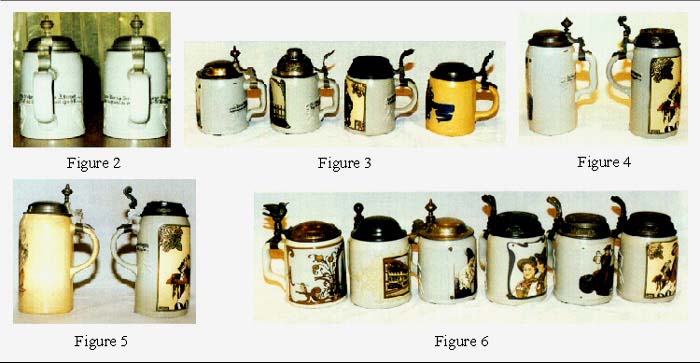 |
The early tapestries used hatching (close parallel lines of stitches) and crosshatching (a close set of parallel lines which is perpendicular to another set of parallel lines) as a means of shading or gradation from one color to another. This created the illusion of light and shade as well as folds in clothing. This technique produced a three dimensional effect in the work.
Germany’s tapestry production declined greatly in the latter part of the 18th century but revived during the historicism, or Historismus, period of the 19th century. During this period, artists utilized historical forms, precedents and principles. Mettlach’s tapestry steins may have been a reflection of the use of the tapestry as a historical artistic form. The first tapestry stein form numbers produced by Mettlach reflect the use of borderless monochromatic backgrounds, pictorial representations of people in daily life and cross hatching and hatching to create shading and gradation from one color to another. Most of the later form numbers of tapestry steins produced by Mettlach reflect the beginning of the Jugendstil or art nouveau style which became popular at the turn of the century. They have colorful free-form borders, and the last five tapestry stein form numbers have tapestry panels with colored backgrounds. The abstract shape of the hops bud, a shape which was popular on the art nouveau steins of the early 1900s, was used on the postman and Tyrolean woman tapestry steins (form numbers 3084, 3085, 3086 and 3087). Therefore, there were changes within the group of steins known as tapestry steins which reflected the art movement prevalent at the time that each of the form numbers was first produced.
Tapestry Steins in General
The Body Sizes
Most tapestry stein form numbers come in 1/2 and 1 liter sizes. Several also come in 1/4 or 3/10 liter sizes. The 1/4 or 3/10 liter size is slightly smaller in diameter and height than the 1/2 liter size. The tapestry is also slightly smaller, but the rear banner is approximately the same size as on the 1/2 and 1 liter sizes. The 1/2 and 1 liter size tapestry stein bases are flat; they do not have false bottoms. The 1/4 or 3/10 liter tapestry steins have a false bottom approximately 1/2 inch deep.
 |
In comparison to the 1/2 liter size tapestry steins, the 1 liter steins have approximately the same body diameter and are approximately 75% taller. The tapestry is only 50% larger on the 1 liter size than on the 1/2 liter size, and generally the figure on the tapestry is only 25% larger. However, on the 1 liter size of form numbers 1533, 1536, 1646, 1647 and 1648, the central character is only slightly larger than the 1/2 liter size because the front tapestry panel also incorporates the verse.
There are certain form numbers that come only in the 1/2 liter size and others that come only in the 1 liter size. The form numbers of the tapestry steins that come only in 1/2 liter size are 1698, 1798 and 1812 (these are also the only three tapestry steins that do not depict people), while those that come only in 1 liter size are 1649, 1650, 1756, 1757, 1758 and 1759. There are also three form numbers of master steins for the tapestry steins. These are 1736, 3084 and 3086. Interestingly, none of the three master steins is a tapestry stein. Form number 1736, which comes in two variations (plain and full color relied, is a 3.0 liter relief stein while the other two form numbers are 3.1 liter etched steins. Even though these steins are not tapestry steins, they will be discussed below because they are the master steins for six tapestry stein form numbers.
The Groups of Tapestry Steins
The tapestry steins can be divided into four groups based on certain characteristics that each group demonstrates. The first group will be referred to in this article as the early tapestry steins. This group includes form numbers 1533, 1536, 1641, 1642, 1643, 1644, 1645, 1646, 1647, 1648, 1649, 1650 and 1662. This group has banners on the rear of all of the 1/2 liter size steins and most of the 1 liter steins. The only 1 liter steins that did not have rear banners in this group are form numbers 1533, 1536, 1646, 1647 and 1648. These steins have the verses incorporated into the front tapestry panels. Generally, the verses on the rear banners of this group vary even between steins in the same size and form number (“nonform specific”). See figure 2. The only form number that I have identified with a varied verse on the front panel is the 1 liter size of form 1533. That stein can bear one of two verses. Most of the steins in this group have optional plain gray inlaid lids.
The second group, consisting of form numbers 1698, 1798 and 1812, depicts buildings and will be referred to in this article as the building tapestry steins. This group apparently did not have an optional inlaid lid and had no rear banners. The only “verses” on these steins are the words “Alte Fink” on the building on form number 1698 and the identification of the Ulm Cathedral on form number 1812. This group also has elaborate borders around the central design.
The third group will hereinafter be referred to as the relief tapestry steins and includes form numbers 1756, 1757, 1758 and 1759. This group has tapestry panels which are not etched but are full color relief. The group has optional inlaid lids but no rear banners. The verses were incorporated into the bottom of the front tapestry panel. Each form number has a specific verse (“form specific”).
The fourth group of tapestries will be referred to as the later tapestry steins and includes form numbers 2823, 2878, 2966, 2967, 3085 and 3087. Every stein in this group has a rear banner and verses which were form-specific. This group did not have optional inlaid lids, and most of the form numbers demonstrated the influence of the art nouveau period.
The Stein Bodies
The bodies used on the tapestry steins are essentially the form number 1526 body. Most tapestry stein form numbers used what I refer to as a “flattened” handle which was changed to the rounded handle found on form number 1526 bodies on the last two tapestry form numbers (see figures 3 through 5). There is a lip or edge around the bottom of the body of the stein. The gray stoneware bodies vary greatly in shade from almost white on some of the earliest manufactured tapestry steins to gray and, finally, to a bluish gray on some of the last manufactured tapestry steins. The interior of the steins was glazed using the usual white glaze applied to the interior of most Mettlach steins.
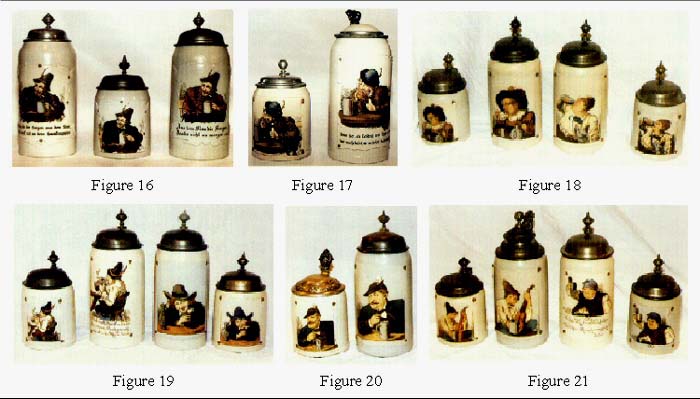 |
The exterior of the body of the earliest produced versions of form numbers 1533 and 1536 is smooth. The bodies of the subsequently produced copies of these two form numbers, as well as all other tapestry steins, had texture added by the application of a series of circles, diamonds or other shapes pressed into the outer body of the stein. The texture on the bodies of the tapestry steins became much more uniform in succeeding years of production.
The tapestry panel and banner were applied to the body of the stein and are raised above the body surface. The design on the front tapestry panel is etched on all but one of the tapestry stein form numbers that are currently known. That one exception, form number 1812, utilizes an etched tapestry panel in which the center was left blank for insertion of a print under glaze (“P.U.G.”) depiction of the Ulm Cathedral.
Most of the tapestry panels are essentially rectangular. The panels do not have borders and their edges are free form, giving the appearance of the edges of an old tapestry. Form numbers 1698 and 1798 have fancy scrolling patterns surrounding the etched pictures of the buildings. Form number 1812 has a panel that is essentially rectangular but covers approximately 2/3 of the body surface. Form number 1533 has a fancy edged panel. Each of the relief tapestry steins (form numbers 1756, 1757, 1758 and 1759) has a beige colored relief border, while form numbers 2823, 2878, 2967, 3085 and 3087 have art nouveau stylized free form full color borders.
Each of the tapestry steins, except form numbers 2967, 3085 and 3087, and the later editions of form number 1533 in the 1 liter size, have nail heads in the four corners of the tapestry panel to depict the tapestry “hung” on the stein (see figures 6 and 7). The textured gray background color of the stein body may have been created to aesthetically depict the rough hewn stone walls of the castle. Most of the early tapestry stein form numbers have nail heads that are full color raised relief while the later form numbers and some versions of form number 1533 are simply circles stamped into the tapestry which have then been colored brown.
There are two versions of the applied raised rear banners (see figure 8). The early rear banners are wider and also have full color raised relief nail heads “affixing” the banner to the stein. The second version is a fluttering type banner which does not have the nail heads and is thinner.
Based upon my research, it appears that the front panel was applied to the textured body. It also appears that, where they exist, the rear banner was applied to the textured body under the handle. My belief that the tapestry-like front panel was applied to the textured body is based upon my examination of approximately 150 tapestry steins. I found a few tapestry steins on which the tapestry panel was separated slightly from the body at one of the tapestry edges and several with bubbles under the tapestry. I also found several steins which had small flakes or chips to the edges or corners of the tapestry or banner which exposed the textured body beneath the chipped area. On several of the steins I examined, the textured design of the body could be seen on the tapestry panel as if it had seeped through from under the tapestry. A large number of steins with the same form number have marked differences in the placement of the tapestry panel on the stein body. The difference in the tapestry panel placement existed even where the steins were manufactured in the same year (see figure 9). The placement of the tapestry panel was often so low on the stein body that it appeared as if the lower edge of the tapestry was cut off and straightened to fit along the base edge or lip of the stein (see figure 10). In addition, I have examined one example of form number 1642 in the 1/2 liter size where the banner which is normally on the rear of the stein was left off during the manufacturing process (see figure 11). I also believe the non-form specific verses on the rear of the early tapestry steins also demonstrates that they were applied to the finished body.
The Lids and Thumblifts
Most of the examples of the early group of tapestry steins that exist have domed pewter lids. However, fancy pewter lids and inlaid lids containing a plain gray inlay were available (see figures 12 and 13). The thumblifts on the steins with the domed pewter lids were attached to the part of the strap attached to the lids as they had been prior to the mid-nineteenth century. These thumblifts look like Seattle’s Space Needle. They are side-sitting ovoid shapes with spire shaped protrusions rising from them. The steins with fancy pewter lids have varied thumblifts which are usually placed over the hinge. The steins with inlaid lids have thumblifts which may be placed in either position.
The building group of tapestry steins have varied lids and thumblifts. Form number 1698 has a rounded dome pewter lid with a ball thumblift which is positioned over the hinge. Form number 1798 has a domed lid or a fancy pewter lid. Form number 1812 has a silver plated lid. The thumblift is an Ulm sparrow carrying a twig. It is located over the hinge.
The relief tapestry steins have either a domed pewter lid or an inlaid lid. The pewter lid and thumblift are identical to those found on most of the early group of tapestry steins. The steins with inlaid lids have the same inlay found on form number 1744, a gray textured inlay with a raised glazed outline of the brewers’ star. Between each pair of points is a raised outline of a glazed hops bud. Inside the hexagram created by the outline of the brewers’ star is a glazed circle containing an etched and glazed Munich Child. The thumblifts on this group of steins are positioned over the hinge (see figure 14).
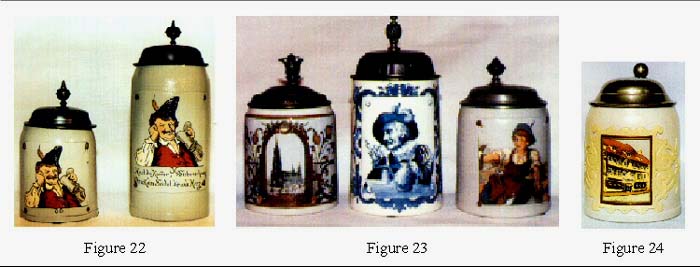 |
The later group of tapestry steins usually have raised flat topped lids with embossed designs. Most of these lids bear the raised design depicting the target girl or Schützenliesl holding a beer in her right hand and leaning her left forearm on a keg (see figure 14). A target is over her head and a banner for inscriptions is beneath her. Form number 2823 has an embossed lid with a target on it (see figure 15). On either side of the target are an olive branch and an oak branch. Crossed guns are positioned at the bottom of the target. Below the target is an inscription area, a heart in a shield. A verse is above the target. On each of the steins with this type of lid, the thumblift is positioned over the hinge. Form number 2967 has a domed pewter lid which has an inscription area. A raised pedestal with a shield on top comes out of the center of the lid. A number of other lids, including a plain domed pewter lid, are also found on these steins.
The Individual Form Numbers
All form numbers except form number 1650 have specific designs on their tapestry-like front panels. Many of the steins were designed by Christian Warth. The following will address the scene on each form number.
Form Number 1533
This stein depicts a seated, bearded highlander with his elbows leaning on a table. In his left hand is a gray stoneware mug.
The earlier manufactured steins have a smooth body with a smaller diameter (by between 1/4 and 1/2 inch) opening. The early version of the 1/2 liter size has a different shaped banner which is “attached” to the body by “nail heads.” Five nail heads are used on the 1/2 liter and six on the 1 liter steins to attach the front tapestry to the stein, except on the later editions where the nail heads are eliminated from the design. Warth’s signature is in the lower right-hand corner. See figure 16.
Form Number 1536
The scene on this stein is a bearded highlander smoking a pipe while he is seated at a table with a stein to his right. He appears pensive, with his right elbow resting on the table and his head resting on his right hand while his feathered hat sits askew on his head. Warth’s signature is located in the lower right portion of the tapestry. See figure 17.
Form Number 1641
The figure on this stein is dressed in old Dutch clothing. He is seated at a table smoking what appears to be a clay pipe. In front of him is a jug and beaker. Warth’s signature is in the lower left corner. See figure 18.
Form Number 1642
This stein shows an artist sitting with his elbows on a table drinking what appears to be a glass of beer. To his left is a “master” stein apparently at the ready to fill his glass. This stein is signed by Warth. His signature is at the bottom in either corner. See figure 19.
Form Number 1643
On this stein a student who is a member of a dueling student society is sitting on his chair with his faithful dog at his side. The student is drinking out of a tapestry stein. See figure 18.
Form Number 1644
Here a mustachioed hunter sits with his right elbow on a table, smoking a cigar. A stein of beer sits in front of him on the table. Warth’s signature is in the lower left corner. See figure 20.
Form Number 1645
This stein depicts a musician sitting at a table with a guitar in his left hand and a stein in his right. Warth’s signature is in the lower left corner. See figure 21.
Form Number 1646
The design of this stein depicts a highlander sitting on a chair at a table using two hands to guide a stein to his mouth while his right hand holds a small clay pipe. See figure 19.
Form Number 1647
On this stein a scowling farmer is holding up a small stein of beer in his right hand, as if in a toast. See figure 21.
Form Number 1648
The mustachioed highlander depicted on this stein is wearing a vest and resting his head on his right hand while getting ready to drink from a raised stein in his left hand. See figure 22.
Form Number 1649
The young man depicted on this stein is bent over with his elbows resting atop a shield depicting a spouted metal pouring vessel. The man and shield appear to be standing on a branch. The man’s hat has a long feather and clay pipe in the hatband. He is holding something indistinguishable in his right hand, and he is wearing an apron. In his right front pants pocket are what appear to be tools. This stein may represent a young carpenter who just finished carving the sign. The color of the shield and the feather in the man’s hat varies from brown to red on different steins of this form number. See figure 9.
Form Number 1650
While researching this article I was surprised to discover that there are two different versions of this stein. The later version, which is the only one that I have seen shown in stein books and auction catalogues, depicts a mountaineer standing on a mountain wearing a coat and lederhosen. He has a backpack and a flask on his right side. In his left hand he holds an ice axe attached to an end of a long walking stick.
 |
The other version (of which I have only seen one copy) was made in 1885, approximately one year earlier than the first year of production of this form number using the Wilson graph or the formula. While the pose struck by the mountaineer in the earlier version is similar to the pose in the later version, the scene depicted on the stein is very different. The face and head of the mountaineer are different as are the clothes he is wearing. The mountaineer in the earlier version has his coat draped over his shoulders and is wearing a vest. He is not wearing a backpack or flask but is wearing a wide belt. The hat held in his right hand is different from the hat in the later version. The way in which he is holding the hat is also different.
On the earlier version, the walking stick does not contain an ice axe, his sock tops are not folded over, and his shoes are different. The shadow which the mountaineer casts in the earlier version is at a different angle than on the later version. There is only one bird flying over the mountaintops on the earlier version, whereas there are two flying in the later version. The shapes of the mountaintops in the distance on the right of the scene and the mountainside, rock and shrub on the left of the scene are also different. Both versions are signed on the rock in the lower left corner by Gorig. See figure 1.
Form Number 1662
The blacksmith journeyman shown on this stein is taking a break with a foaming stein of beer raised in his right hand. He is wearing a heavy apron used to shield his clothing from the sparks that come from hammering red hot metal. In his belt are a hammer for shaping the metal and a pair of tongs for holding the metal while it is being shaped. See figure 23.
Form Number 1698
This form number, found only in the 1/2 liter size, depicts the Alte Fink, a famous student tavern in Göttingen, Germany, which existed as a tavern until World War II. The building still exists in Göttingen’s city center not far from the university. Most of the lids on the steins that I studied have student dueling society inscriptions. See figure 24.
Form Number 1736
This relief stein is the “master” to form numbers 1756 through 1759, the relief tapestry steins. The stein has a brown background. The inlay bears relief hops buds, and there are relief hops buds and wheat ears on the body. The body is divided into four panels. Above each of the panels is a banner bearing one-fourth of the verse and a small shield. The background and the figures are either blue with white relief figures or magenta with full color relief figures. The figure on the front panel is the figure from form number 1756. In the shield above the panel is a second shield. To the left of the front panel is the figure from form number 1757, and the shield contains a key. The figure to the right of the front panel is the figure from form number 1759, and in the shield above the panel is a corkscrew. At the back of the stein is the figure from form number 1758. See figures 25 through 29.
Form Number 1756
This full-color relief tapestry depicts a student from a dueling society drinking from a stein of beer with a student coat-of-arms. He bears a bandage on his left cheek, a student hat and a sash. He appears to be seated with his left arm draped over the back of a chair. The student is in full-color relief as are the central figures in all four steins in this series.
There is a beige relief frame surrounding the tapestry in the series, but the background of the tapestry is the textured body of the stein colored in magenta. The verse is on the bottom of the frame immediately beneath the portrait. There are banners coming off either side of the bottom of the frame. Warth’s signature is on the banner to the right of the scene. On each side of the tapestry are full color relief hops vines. See figures 25 and 26.
Form Number 1757
The central figure on this stein is a man wearing an apron with a cigar in one hand and a mug in the other. See figures 25 and 27. See form number 1756 for a description of the layout of this stein.
Form Number 1758
The central figure on this stein is a soldier holding a mug in his right hand. See figures 25 and 29. See form number 1756 for a description of the layout of this stein.
Form Number 1759
The central figure on this stein is a fancy dressed man smoking a pipe which he is holding in his left hand. This scene differs from the corresponding scene on the master stein because you cannot see his right hand, forearm, or what he is holding, whereas on the master stein (form number 1736) he is holding a beaker. See figures 25 and 28. See form number 1756 for a description of the layout of this stein.
Form Number 1798
I have not been able to identify the building depicted in this scene. It appears to be either immediately inside or outside a walled city or compound at the base of a hill. Because of the rarity of the stein, I believe it was a special order for a hotel or inn. See figure 30.
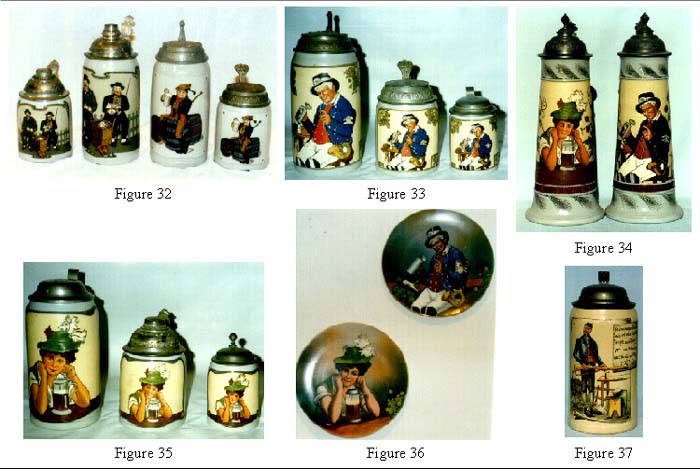 |
Form Number 1812
This form number is not referred to in the book of Mettlach catalogues or in The Mettlach Book and has only sold once at auction. It differs from all other tapestry steins in two ways: its tapestry panel covers approximately 3/4 of the body of the stein, and the panel is not entirely etched but instead contains a P.U.G. depiction of the Ulm cathedral or Münster in a center panel.
The tapestry has a brown frame and it is “secured” to the body by six gray points in the frame, three on either side of the tapestry. The frame has straight edges on top and bottom and is ornate at each of the six points where the tapestry is “secured.”
The center panel of the tapestry is domeshaped and ornately framed in brown. It has the appearance of a window which, when you are looking out of it, has a slightly down-looking view of the Münster. At the bottom of the frame is etched “Münster in Ulm.” At the top of the window frame are vines and what appears to be the shield for the city of Ulm. To either side of the center panel on the tapestry is what appears to be some additional brown framing and flowering vines against a slightly darker gray background. Also etched into the two sides of the tapestry is a sparrow with a twig in its beak. The head of each sparrow is turned toward the center panel depicting the Münster.
The thumblift is a sparrow with slightly raised wings and a twig in its beak nesting on a pedestal.
The city of Ulm is situated on the Danube River. It has been an important trading center since the Middle Ages. It was chartered in 1164 and became directly subordinate to the Emperor in 1274. It has two ring walls. The first defines the core of the old town and the second, built in the 14th Century, enclosed so large an area that the city did not outgrow it until the 19th century.
The city is known to tourists for, among other things, the Münster. This cathedral is one of the most important ecclesiastical buildings in Europe. It is 135 yards long, 53 yards wide at the nave, 136 feet high and has an area of 5577 square yards. The main tower, on the west side of the cathedral, is 528 feet high and is the highest church spire in the world. Building began in 1377 and was not completed until 1890. The stein is dated 1887, some three years before the completion of the cathedral and approximately one year earlier than the result obtained using the Wilson graph. This stein may have been made or commissioned in honor of the completion of the cathedral. Why there were apparently so few made is not known.
The sparrows depicted on the stein body and thumblift are Ulmer Spatze. The legend surrounding these birds is that construction of the spire was halted one-half way when a wagon loaded with a wooden beam loaded sideways arrived at the narrow city gate and could not be brought into the city the way it was positioned. After contemplating how best to proceed, the mayor of Ulm gave the order to tear down part of the city wall. However, before the order was carried out, a sparrow was observed maneuvering a long twig into its nest lengthwise. Following the sparrow’s lead, the beam was turned and the wagon passed through the narrow gate, allowing work to resume and the cathedral to be completed. See figure 23.
Form Number 2823
On this stein a woman bearing a rifle over her right shoulder is holding a target in her left hand. See figure 31.
Form Number 2878
This stein depicts two Tyrolean women conversing with each other while dressed in their traditional garb. See figure 31.
Form Number 2966
On this stein, a man sits atop a barrel with a foaming stein of beer in his right hand. Two other barrels are in the scene. The barrel to the left of the scene is lying on its side and bears the Höfbrau “HB” symbol. See figure 32.
Form Number 2967
Two farmers are sitting on stools in front of a low fence on this stein. Each of the farmers has a piglet in his lap. A third piglet is poking his head above the top of the basket which is in the foreground. See figure 32.
Form Numbers 3084 and 3085
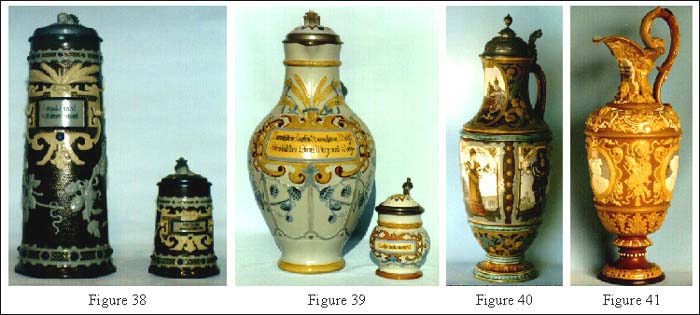 |
The seated Bavarian postman shown on these form numbers is looking down into a stein which happens to be a 1 liter size Mettlach form number 3085 Bavarian postman tapestry stein. There are two white radishes on the table behind the postman. The green bordered tapestry on form number 3085 has a white background and hops buds and leaves in each of the upper corners. In the lower left corner there is a linear design, and in the lower right corner there is a Bavarian lion. A brewery apparently commissioned a version of this one liter stein, changing the rear banner to read: “Erste Kulmbacher Actien-Exportbier-Brauerei.”
The master stein (form number 3084) is not a tapestry stein. It has a full wraparound etched panel. The scene is similar to form number 3085, but there are hops vines on either side of the postman. Above and below the scene are gray bands which contain etched barley spikes. The verse is contained on a red band between the lower portion of the scene and the bottom band of barley spikes. See figures 33 and 34.
Form Numbers 3086 and 3087
A Tyrolean woman is sitting with her elbows on a table on this stein. Her hands are supporting her head and she is staring straight ahead. A one-half full glass stein of beer sits on the table in front of her. Form number 3087 has hops buds in the lower corners, a blue free form border, and a white tapestry background.
The master stein (form number 3086), like form number 3084, is also not a tapestry stein. It has a full wraparound etched scene with barley spikes etched into the gray body above and below the scene. The master has hops vines etched into the white background on either side of the woman. The verse on this stein is also etched into a red band between the bottom of the scene and the lower area of barley spikes. See figures 34 and 35.
The above information is contained in condensed form in the two accompanying charts. Chart I provides the translations for the verses found on tapestry steins, and Chart II provides the scene description, sizes, lid availability, verses and number of auction sales for the period 1982 through September 1, 1996 for each form number.
Other Tapestry-Related Mettlach Wares
In addition to the tapestry steins and nontapestry master steins discussed above, there are four plaques and several other steins which should be addressed.
There are two P.U.G. plaques, form numbers 1044/412 and 1044/411, which depict the central scenes on the Bavarian postman and Tyrolean woman steins (form numbers 3085 and 3087) respectively. See figure 36. As with the master steins, the plaques do not depict a tapestry; the plaques show the central characters of tapestry stein form numbers 3085 and 3087. Each of the plaques has a colored background, not the white background that is on the steins. The Tyrolean woman plaque has a small piece of hops vine in the lower right hand area of the plaque, not the hops buds depicted on the tapestry on stein form number 3087. The postman on the plaque is drinking out of a plain stein, not a postman tapestry stein as shown on form numbers 3084 and 3085. Part of a hops vine is also present on the lower right hand area of this plaque, while the corner decorations on the tapestry on stein form number 3085 have been eliminated. Both plaques were made in three sizes, i.e., 12", 14" and 17 1/2".
Mettlach also produced two Delft stein form numbers which depict a tapestry hung on a stein body, form numbers 5188 and 5191. Form number 5188 came in 1/2 and 1 liter sizes. Form number 5191 is a 3/10 liter size stein. Both form numbers depict the same tapestry. The tapestry shows a man in old Dutch clothing smoking a clay pipe which he is holding in his right hand. The man’s left hand is holding an open master stein which is resting on a table next to a beaker. The scene on these form numbers, including the man, his pose, his clothing and the objects on the table, is almost identical to the scene on tapestry stein form number 1641. (Note that the Rookwood-type stein, form number 2792/6137 also has the same scene as is depicted on tapestry stein form number 1641 and Delft stein form numbers 5188 and 5191.)
There are no verses on the Delft “tapestry” steins. Each stein body is white, and the painted design under the glaze is blue.
There is a small scene on each side of the tapestry on these Delft steins which depicts a grouping of drinking and pouring vessels as well as hops vines, barley spikes and pipes. Form number 5188 has an ornate border surrounding the tapestry which is not part of the tapestry. Form number 5191 has no border. The only lids available were pewter lids, and the 1 liter version of form number 5188 has a pewter footring. (See figure 23.) These form numbers are not included above because they do not have a gray body, a raised tapestry panel or a verse. However, because the design depicts a tapestry, they are mentioned here for reference.
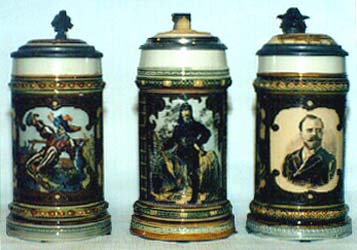 |
Several of the early P.U.G. decorations simulate tapestries nailed or screwed to the body, e.g., decoration numbers 595, 596, 597, 598 and 639. See figure number 37. These decorations were developed at about the same time as the early tapestry steins. The verses on the P.U.G. steins are either contained on the tapestries or in a box which appears to sit over a corner of the tapestry. These steins do not have gray bodies or raised tapestry panels.
A number of other Mettlach steins share one or more traits with the tapestry steins. Form numbers 1737 and 1745 have a scroll containing only a verse applied to a brown textured body. See figure number 38. Form numbers 1738 and 1744 are threaded relief steins with a scroll containing a verse applied to the stein. See figure number 39. The etched framed scenes on form number 2300 are “nailed” to the body as are the cartouches on form number 1568. See figures numbered 40 and 41 respectively. Other etched steins also have panels which appear to be “nailed” to the stein, e.g., form numbers 1724, 1796 and 2136. See figure number 42. However, these steins also do not fit within the definition of tapestry steins because they are not gray bodied steins to which a raised panel with a scene has been applied.
Conclusion
As I have hopefully been able to demonstrate, tapestry steins are a fascinating group. As a group they combine history, art movements and styles in a way that is not seen in any other set or group of Mettlach steins because of the long period of time over which the group was designed. The simplicity of the overall design of each stein combined with the colorful center panel leads to an attractive grouping when several are placed together. Hopefully collectors will begin to appreciate these steins rather than look at them as a “lesser class” of Mettlach wares.
__________
1 Although they are not technically tapestry steins, the group of steins known as “relief tapestry” steins (form numbers 1756 through 1759) are included in this article because: (a) they have gray bodies; and (b) a number of collectors refer to them simply as tapestry steins.
2 The first years of production of form numbers 1533 and 3087 (the first and last form numbers of the tapestry steins produced by Mettlach). These dates are calculated by applying the graph devised by Robert Wilson (“Wilson graph”) (See Prosit, Vol. 1, No. 57, p. 597) or the formula Y+ 1/3Y+ 65 where Y represents the first two digits of a four digit form number (“the formula”), e.g., 15+5+65=85 or 1885 and 30+10+65=105 or 1905.
Bibliography
Bentley, James, Blue Guide Germany, W.W. Norton, New York, 1987
Eisenman, Stephen F., Thomas Crow, Brian Lukacher, Linda Nochlin and Frances K. Pohl, Nineteenth Century Art: A Critical History, Thames & Hudson Ltd., London, 1994
Encyclopedia of World Art, Volumes I and XIII, McGraw-Hill Book Company, Inc., New York, 1995.
Fodor’s 1995 Germany, Fodor’s Travel Publications, Inc., New York, 1995.
Germany: A Phaidon Cultural Guide, Prentice Hall, Inc., Englewood Cliffs, New Jersey, 1985.
Graydon, Don, Editor, Mountaineering: The Freedom of the Hills (Fifth Edition), The Mountaineers, Seattle, Washington, 1992.
Haslam, Malcolm, In The Nouveau Style, Bullfinch Press (Little, Brown and Company), Boston, 1990.
Honour, Hugh and John Fleming, The Visual Arts: A History, Prentice-Hall, Inc., Englewood Cliffs, New Jersey, 1982.
Hopper, Colonel Les, AUS(Ret), Ein Tausend Und Eine Uebersetzongen von Deutschen Bierkrug Sprueche (1001 German Beer Stein Translations), Al E. Gator Press, New Orleans, Louisiana, 1994.
Jarry, Madeleine, World Tapestry (From Its Origins To the Present), G.P. Putnam’s Sons, New York, 1969.
Kane, Robert S., Germany at its Best, Passport Book, Lincolnwood, Illinois, 1988.
Kirsner, Gary, The Mettlach Book, Glentiques Ltd., Inc., Coral Springs, Florida, 1994.
Lopez, Liselotte, Schutzenliesl or Target Girl Beer Steins, Prosit, Vol. 1, No. 100, June, 1990
Michelin Hotels-Restaurants Deutschland, Michelin Reifenwerke KGaA, Karlsruhe, Germany, 1996.
Phillips, Barty, Tapestry, Phaidon Press Limited, London, 1994.
“Solidarität unter den Sammlern,” Mettlacher Turm, December, 1994.
Thomas, Dr. Therese and Anton Post, Mettlacher Steinzeug 1885-1905, Hans T. Ammelounx, Wheeling, Illinois, 1975.
Trainer, Bill, “Mettlach Tapestries,” Stein Talk, Issue #67, Spring, 1993.
Vodges, Walter B., “Die Ulmer Spotze–A Rare Bird,” Prosit, Vol. 2, No. 1, March, 1992.
“Wer Hilft mit zu Identifizieren?” Mettlacher Turm, September, 1994.
Wilson, Robert D., “Date Your Mettlach Steins,” Prosit, Vol. 1, No. 57, September, 1979.
__________
*Reprinted by permission from Prosit, the Journal of Stein Collectors International, Vol 2, No. 20, December 1996